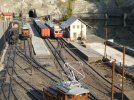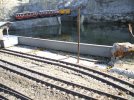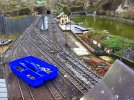RB Overhead Build, this has been a long time coming but recent talk by
 grizzmo
has prompted me to get on with it after promising him some info.
grizzmo
has prompted me to get on with it after promising him some info.
I was tasked by Andy to do the overhead, to be honest it was a bit daunting at first especially when he showed me the first example of what he wanted as a support mast. Here you can see his example and in situ my ‘working’ example. Whilst the in situ one may look to be banged in, in had been fitted with nuts at the bottom and held in place on extension flats of steel plate then screwed in place.
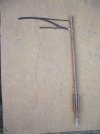
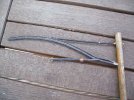
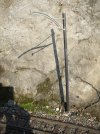
However viewing this and thinking about the location for much of the day in full sun it was clear that movement and expansion were going to be very significant issues. Thus our collective thinking hats were donned. It was very apparent that the example would not do for Millisee where there were 4 tracks and 2 platform faces. Also these would not be that appropriate over the Dam where something more impressive was called for. Thus the Post and Wire across Millisee was decided upon, his example for the fiddle yard branch and Spans made for the Dam.
We went to BnQ and found suitable sized Steel Rod 1/4 inch I think or 7-8mm in new money. We got a lot of full lengths for the job. These were taken to my home in Hemal Hempstead, some cut to the agreed length and turned to have 2 ridges at the top for Cross Wires. These would be banged into the paving slabs used for the track base into holes very slightly under size to give a good tight fit. Some has thread put on the bottom for the Fiddle Yard Branch.
Whilst this was going on Andy put his mind to how the Pantograph Wire the Second Wire above would be all fitted to allow movement. He came up with Buttons, these were adapted from what appear to be Meccano sized brass bolts, a goodly supply of which he happened to have in stock. The buttons had flats filed on the thread with a hole drilled for the cross wire, the screwdriver bit was opened out to take the overhead wire which was around 35thou brass wire in size. A later addition was a small hacksawed gap to match the screwdriver gap orientation for the Holding Wire to sit in place, this would thus allow movement of the Pantograph and Top wire across the Buttons for expansion etc.
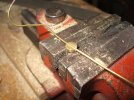
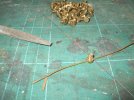
Having come up with a plan construction was started, I did the easy bit first banging the poles into the paving slabs on Millisee station. Next up was to do the cross wires also of the 35thou brass wire. Once this was in place running of Overhead Locomotives had to cease for a while as Andy would not run his machines ‘pan down’. Fortunately I had by now a good collection of larger locomotives so was able to fill the roster gap on running sessions. But the pressure was now on! Below many of the poles in place plus the Overhead Installation Train, a handy place for bits and bobs to be kept.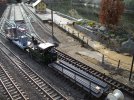
Still at least the bits to do were reduced by the fact that some 70% of the main line was out of view and fiddle yards did not need overhead just clearances for Pans Up which had been allowed for at the build with Push Down Rods where required for tunnel mouths etc. Also the branch to Carolstadt would be unwired as this was Steam and Diesel Railcar run.
I was tasked by Andy to do the overhead, to be honest it was a bit daunting at first especially when he showed me the first example of what he wanted as a support mast. Here you can see his example and in situ my ‘working’ example. Whilst the in situ one may look to be banged in, in had been fitted with nuts at the bottom and held in place on extension flats of steel plate then screwed in place.



However viewing this and thinking about the location for much of the day in full sun it was clear that movement and expansion were going to be very significant issues. Thus our collective thinking hats were donned. It was very apparent that the example would not do for Millisee where there were 4 tracks and 2 platform faces. Also these would not be that appropriate over the Dam where something more impressive was called for. Thus the Post and Wire across Millisee was decided upon, his example for the fiddle yard branch and Spans made for the Dam.
We went to BnQ and found suitable sized Steel Rod 1/4 inch I think or 7-8mm in new money. We got a lot of full lengths for the job. These were taken to my home in Hemal Hempstead, some cut to the agreed length and turned to have 2 ridges at the top for Cross Wires. These would be banged into the paving slabs used for the track base into holes very slightly under size to give a good tight fit. Some has thread put on the bottom for the Fiddle Yard Branch.
Whilst this was going on Andy put his mind to how the Pantograph Wire the Second Wire above would be all fitted to allow movement. He came up with Buttons, these were adapted from what appear to be Meccano sized brass bolts, a goodly supply of which he happened to have in stock. The buttons had flats filed on the thread with a hole drilled for the cross wire, the screwdriver bit was opened out to take the overhead wire which was around 35thou brass wire in size. A later addition was a small hacksawed gap to match the screwdriver gap orientation for the Holding Wire to sit in place, this would thus allow movement of the Pantograph and Top wire across the Buttons for expansion etc.


Having come up with a plan construction was started, I did the easy bit first banging the poles into the paving slabs on Millisee station. Next up was to do the cross wires also of the 35thou brass wire. Once this was in place running of Overhead Locomotives had to cease for a while as Andy would not run his machines ‘pan down’. Fortunately I had by now a good collection of larger locomotives so was able to fill the roster gap on running sessions. But the pressure was now on! Below many of the poles in place plus the Overhead Installation Train, a handy place for bits and bobs to be kept.

Still at least the bits to do were reduced by the fact that some 70% of the main line was out of view and fiddle yards did not need overhead just clearances for Pans Up which had been allowed for at the build with Push Down Rods where required for tunnel mouths etc. Also the branch to Carolstadt would be unwired as this was Steam and Diesel Railcar run.
Last edited:

